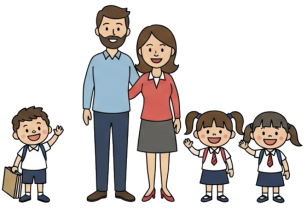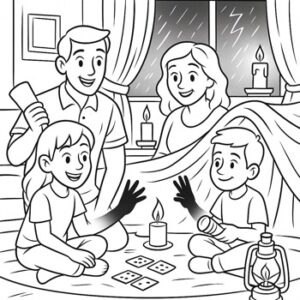
Question More, Action Knowledge.
Remember, at QMAK, we don’t just teach; we empower. We don’t just inform; we inspire. We don’t just question; we act. Become a Gold Member, and let’s unlock your child’s full potential, one question at a time.
Here you will find the resources that compliment the lessons taught during the month.
Songs are a great way to reinforce lessons in a fun, memorable way—by engaging musical and auditory learning styles, they help key ideas stick in children’s minds and support long-term retention well beyond the lesson.
Verse 1:
Training wheels on a bicycle ride
Extra cables on an elevator glide
Two kidneys when just one would do
Nature’s got some backups too
Like a safety net that’s always there
Catching us when we need extra care
Pre-Chorus:
It’s not about if things go wrong
It’s about staying safe and strong
Having plans B, C, and D
That’s how fail safes set us free
Chorus:
Just in case, just in case
We’ve got backup plans in place
Like a spare tire on a car
Or a flashlight in the dark
There’s no need to worry or to fear
‘Cause our fail safes are always here
Just in case, just in case
We’ve got backup plans in place
Verse 2:
Smoke alarms watching while we sleep
Emergency brakes help our cars to keep
Safe and sound when trouble’s near
Warning lights make danger clear
Like a friend who’s got your back
Keeping everything on track
(Pre-Chorus)
(Chorus)
Bridge:
Some say we’re too careful
(Better safe than sorry!)
Some say we’re too prepared
(Ready for tomorrow!)
But when the lights go out at night
We’ll be the ones with backup light
‘Cause that’s what fail safes do
They see us safely through!
Chorus:
Just in case, just in case
We’ve got backup plans in place
Like a spare key hidden well
Or a backup show-and-tell
There’s no need to worry or to fear
‘Cause our fail safes are always here
Just in case, just in case
We’ve got backup plans in place
Outro:
(Softly)
Better have it and not need it
Than need it and not have it at all
That’s the fail safe call!
Having your child complete this coloring page right after reading the story helps transition the lesson from imaginative reading to creative expression, turning their thoughts into a vibrant work of art.
Color-In Picture

Movies are a great tool for engaging visual and auditory learners, and when paired with comprehension quizzes, they encourage active viewing—helping children process and retain key concepts rather than just being passively entertained.
Gravity provides a gripping exploration of fail-safe systems through Dr. Ryan Stone’s desperate fight for survival in space.
Through her harrowing journey after a catastrophic accident, students witness how backup systems and redundant safety measures become crucial when primary systems fail.
The film demonstrates fail-safe thinking in action as Stone moves from one contingency plan to another – from emergency oxygen supplies to backup thrusters to alternative spacecraft – showing how layered safety systems can create paths to survival even when disaster strikes.
As viewers follow her intense space-walk sequences, they see how each fail-safe mechanism, though seemingly redundant during normal operations, becomes a vital link in the chain of survival when things go wrong.
The unforgiving environment of space provides the perfect backdrop for understanding why complex systems need multiple layers of protection, as even small failures can cascade into life-threatening situations without proper backup measures.
1. How do the multiple oxygen tanks in Dr. Stone’s suit demonstrate fail-safe systems?
a) They’re unnecessary extra weight
b) They provide backup air supplies when the primary tank fails
c) They make the suit look better
d) They have no safety purpose
2. What role does the tether line serve as a fail-safe in the film’s opening?
a) It’s purely decorative
b) It only restricts movement
c) It prevents astronauts from drifting into space
d) It has no backup purpose
3. How do the different spacecraft in the film represent fail-safe thinking?
a) Each vessel offers another potential survival option
b) They’re all the same
c) They only serve one purpose
d) They provide no backup options
4. What type of fail-safe is demonstrated by the emergency protocols in the space stations?
a) Warning systems only
b) No backup systems
c) Multiple integrated safety measures
d) Simple decoration
5. The presence of multiple communication systems demonstrates what fail-safe principle?
a) Backup systems should be independent from primary ones
b) Systems should be overly complicated
c) Single systems are more reliable
d) Communication isn’t important
6. How does the fire suppression system in the space station demonstrate fail-safes?
a) It automatically activates when needed
b) It only causes problems
c) It serves no purpose
d) It requires manual activation always
7. The manual re-entry procedures represent what aspect of fail-safe design?
a) Systems should only be automatic
b) Complex systems are better
c) No backup is needed
d) Backup systems should be simple and usable
8. What fail-safe principle is shown when Dr. Stone uses alternative propulsion methods?
a) Having only one option is best
b) Multiple solutions for critical functions
c) Backup plans should be complicated
d) No alternatives are needed
9. The pressurized sections of the space station demonstrate what fail-safe concept?
a) Multiple layers of protection
b) Single barriers are sufficient
c) Safety systems aren’t necessary
d) Pressure is unimportant
10. How does the landing capsule’s design reflect fail-safe principles?
a) It has no safety features
b) It has multiple redundant safety systems
c) It relies on a single system
d) It ignores safety completely
1. b
2. c
3. a
4. c
5. a
6. a
7. d
8. b
9. a
10. b
This enchanting story follows the adventures of a young dragon named Diggory, who learns the secrets of mindfulness from a wise old dragon. Through a series of whimsical challenges and delightful encounters, Diggory discovers how to tame his fiery temper, calm his racing thoughts, and find peace and contentment in the present moment.
1. Who is the main character of the book?
a) A knight
b) A princess
c) A dragon
d) A wizard
2. What problem does the dragon have at the beginning of the story?
a) Can’t breathe fire
b) Feels stressed and overwhelmed
c) Can’t fly
d) Has no friends
3. Who teaches the dragon about mindfulness?
a) Another dragon
b) A wise owl
c) His parents
d) A human child
4. What is one of the first mindfulness techniques the dragon learns?
a) Deep breathing
b) Running fast
c) Sleeping all day
d) Eating lots of food
5. How does the dragon practice being present in the moment?
a) By thinking about the future
b) By worrying about the past
c) By focusing on his senses
d) By ignoring everything around him
6. What does the dragon learn about his thoughts?
a) To always believe them
b) To ignore them completely
c) To observe them without judgment
d) To only have happy thoughts
7. How does mindfulness help the dragon?
a) It makes him bigger and stronger
b) It helps him feel calmer and more focused
c) It gives him magical powers
d) It makes him invisible
8. What does the dragon learn about difficult emotions?
a) To avoid them at all costs
b) To express them by breathing fire
c) To acknowledge and accept them
d) To pretend they don’t exist
9. How does the dragon’s behavior change after practicing mindfulness?
a) He becomes more aggressive
b) He sleeps all the time
c) He becomes kinder and more patient
d) He stops interacting with others
10. What is the main message of the book?
a) Dragons are the best at mindfulness
b) Mindfulness is only for magical creatures
c) Mindfulness can help manage stress and emotions
d) Mindfulness is too difficult for children
1. c) A dragon
2. b) Feels stressed and overwhelmed
3. c) His parents
4. a) Deep breathing
5. c) By focusing on his senses
6. c) To observe them without judgment
7. b) It helps him feel calmer and more focused
8. c) To acknowledge and accept them
9. c) He becomes kinder and more patient
10. c) Mindfulness can help manage stress and emotions
Setting “The Time Traveler’s Mind” to music creates a playful way for children to practice mindfulness, transforming abstract concepts about present-moment awareness into a catchy tune they can easily remember. The song provides a simple framework that helps children visualize catching thoughts about the past and future, giving them a musical tool to redirect their attention to the now. This melody makes mindfulness practice feel like an adventure rather than a chore, offering children a friendly tune they can recall whenever their minds wander, helping them develop focus and emotional balance through the joy of music.
Verse 1:
Thoughts like fish in a stream
Past and future, they all teem
But here’s a game we can try
Catch those thoughts as they swim by
Pre-Chorus:
Not yesterday, not tomorrow
Just this moment, let’s follow
Chorus:
Now is where we play
Fishing thoughts away
Past and future in a box
Present moment rocks
Verse 2:
On a lake of memories
Catch the past with gentle ease
Future dreams on hooks we’ll find
Clear the waters of our mind
(Pre-Chorus)
(Chorus)
Bridge:
What’s left when time stands still?
A world of wonder to fulfill
In this moment, fresh and new
Endless possibilities come true
(Chorus)
Outro:
Open your eyes to this magic space
Where now is the only place
In this game of mind and time
We find the present so sublime

Remember, at QMAK, we don’t just teach; we empower. We don’t just inform; we inspire. We don’t just question; we act. Become a Gold Member, and let’s unlock your child’s full potential, one question at a time.